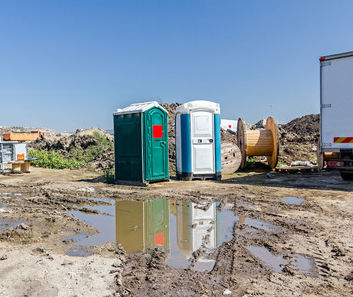02.E.02 Construction Sites.
Toilet facilities on construction sites must be provided as follows (the requirements of this subsection do not apply to mobile crews or to normally unattended work locations if employees working at these locations have transportation immediately available to nearby toilet facilities):

- Where sanitary sewers are not available, job sites must be provided with chemical toilets, re-circulating toilets, or combustion toilets unless prohibited by state/local codes;
- Each toilet facility must be equipped with a toilet seat and toilet seat cover. Each toilet facility - except those specifically designed and designated for females - must be equipped with a metal, plastic, or porcelain urinal trough. All must be provided with an adequate supply of toilet paper and a holder for each seat;
- Note: 1Where toilet facilities will not be used by women, urinals may be provided instead of commodes, except that the number of commodes in such cases must not be reduced to fewer than 2/3 of the minimum number specified. 2One additional toilet fixture for each additional 40 employees.
- Toilets must be provided for each sex according to Table 2-2. Separate toilet rooms for each sex need not be provided if toilet rooms can only be occupied by one person at a time, can be locked from the inside and contain at least one toilet seat;
| Number of employees | Minimum number of Toilets1 |
|---|---|
| 1 to 15 | One (1) |
| 16 to 35 | Two (2) |
| 36 to 55 | Three (3) |
| 56 to 80 | Four (4) |
| 81 to 110 | Five (5) |
| 111 to 150 | Six (6) |
| Over 150 | Refer to Note 2 |
Note:
1Where toilet facilities will not be used by women, urinals may be provided instead of commodes, except that the number of commodes in such cases shall not be reduced to fewer than 2/3 of the minimum number specified.
2 One additional toilet fixture for each additional 40 employees.
- Where it is not practical to provide running water, hand sanitizers may be used as a substitute for running water. Hand sanitizers must contain at least 60% ethyl alcohol as its active ingredient and workers must be trained to properly use the sanitizer.
- Toilet facilities must be constructed so that the occupants are protected against weather and falling objects; all cracks must be sealed; the door must be tight-fitting, self- closing, and capable of being latched from the inside;
- Adequate ventilation must be provided; all windows and vents must be screened; seat boxes must be vented to the outside [minimum vent size 4 in (10.1 cm)] with vent intake located 1 in (2.5 cm) below the seat;
- Toilet facilities must be constructed so that the interior is lighted; and
- Provisions for routinely servicing and cleaning all toilets and disposing of the sewage must be established before placing toilet facilities into operation. The method of sewage disposal and the placement location selected must be in accordance with Federal, state, and local health regulations.
02.E.03
Employees working in temporary field conditions, in mobile crews or in normally unattended work locations must be provided at least one toilet facility unless transportation to nearby toilet facilities is readily available.
Knowledge Check Choose the best answer for the question.
2-6. What must be provided where it is not practical to provide running water to wash hands?
You forgot to answer the question!
